AMD has achieved widespread recognition among enthusiasts for many reasons. One of them is the long-term relevance of platforms that are not replaced unless clearly necessary, which contrasts with the approach of Intel, which changes processor sockets every two generations of CPUs. Thus, the Socket AM4 platform, which appeared back in 2016, is supported to this day: numerous processors with Zen, Zen+, Zen 2 and Zen 3 architectures are compatible with it, including both traditional CPUs and hybrid APUs with powerful integrated graphics.
The Socket AM5 platform that replaced it, thanks to which Ryzen processors now have support for DDR5 and PCIe 5.0, has every chance of becoming just as long-lived. AMD has already committed to releasing new processor models for it at least until 2027, which means that the next generation after the Ryzen 9000 will also be released in the Socket AM5 version. Thanks to this, users of Ryzen systems have the opportunity, after some time, to painlessly change the processor to a newer one, without touching the rest of their PCs.
However, AMD has not yet reached the point where the platform remains completely unchanged throughout the entire life cycle of a particular socket. With the release of each new generation of Ryzen, the company brings to the market fresh sets of system logic, which add certain additives to the platform, forcing motherboard manufacturers not to mark time and improve their products. In particular, along with Ryzen 9000, 800 series chipsets were presented, which brought USB4 and Wi-Fi 7 support to the Socket AM5 platform, at least that’s what it looks like on paper. According to AMD, these high-speed interfaces should encourage some users to switch to more modern motherboards, especially since, among other things, they may contain some circuit improvements independently introduced by their manufacturers.
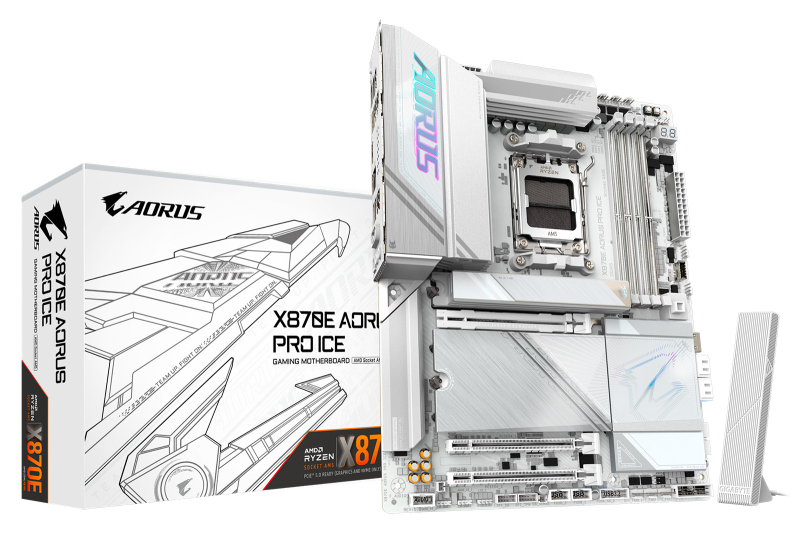
But there is a nuance. In fact, all the work carried out by AMD on the 800 series chipsets came down to simply renaming old chipsets with formally attributing new capabilities to them without making any changes to the chips directly included in the chipsets. In other words, AMD decided to save money and completely replaced engineering work with marketing, through which it created the appearance of progress.
This added headaches to motherboard manufacturers, who were faced with a rather non-trivial task. They had to design new products with essentially the same raw material as two years ago. And in this review we’ll see how Gigabyte dealt with this problem by timing the release of the Ryzen 9000 with a complete update of its Socket AM5 board lineup. The main character today will be the motherboard based on the older AMD X870E system logic set, which belongs to the sub-flagship level – X870E Aorus Pro Ice. The recommended price for this board is $360, while Socket AM5 flagships (for example, Gigabyte X870E Aorus Master) cost about $500. But despite the quite affordable price, the X870E Aorus Pro Ice is not only perfectly equipped and fully reveals the essence of the X870E, but it is also very pretty, being made in the now popular white and silver color scheme.
⇡#What happened to AMD chipsets?
The implementation of external interfaces in modern platforms, both from AMD and Intel, is traditionally divided between the processor and the chipset. The memory controller has long been moved into the processor, plus most CPUs now also have an integrated entry-level graphics core with external HDMI and DisplayPort interfaces. But the functions of the processor SoC, which ensures communication between the processor and the outside world, are not limited to this alone. In modern CPUs, it is also responsible for the operation of some high-speed buses, in particular PCIe 5.0. In this case, the role of the chipset is obviously reduced, but nevertheless does not degenerate completely, since it removes from the processor the burden of supporting slower PCIe 4.0 and 3.0 buses, numerous USB and SATA ports, network capabilities, as well as integrated sound.
It is according to this principle that the functions of the processor and chipset are distributed in the Socket AM5 platform. Thus, representatives of the Ryzen 7000 and Ryzen 9000 families have their own PCIe 5.0 controller with 28 lanes, and also support two USB 3.2 Gen 2 ports with a bandwidth of 10 Gbps. But everything else is provided by the chipset. And that is why the role of the chipset remains quite important – it determines a significant part of the capabilities of modern motherboards.
With the release of the Socket AM5 platform, AMD came up with a clever scheme that allows not only to outsource the development of chipsets completely, but also to unify the options for system logic sets for different price segments. Its essence lies in the fact that the company ordered from ASMedia the development of a universal building block – a hub, which on one side would have an upstream PCIe 4.0 x4 connection, and on the other would support 8 downstream PCIe 4.0 lanes and 4 PCIe 3.0 lanes, a USB 3.2 Gen port 2×2 (20 Gbps), 4 USB 3.2 Gen 2 (10 Gbps), 6 USB 2.0 and 4 SATA ports. And such a hub was developed – now it is widely known under the name Promontory 21. It was this that became the basis for all current chipsets for the Socket AM5 platform – to implement one or another configuration of system logic, AMD uses either one such chip or two chips connected in series ( four PCIe 4.0 lanes). The number of Promontory 21 chips used clearly determines the wealth of external ports and interfaces: sets of two chips are aimed at more expensive systems, and a single chip is a simpler and more affordable option.
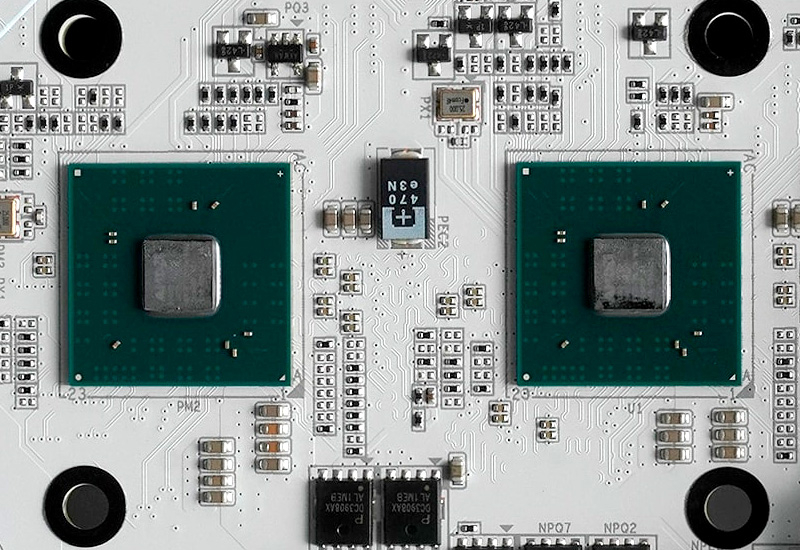
Promontory 21 chips, 2 pcs.
This is exactly how the Socket AM5 chipsets of the first wave were made. The basic B650 involves connecting one Promontory 21 hub to the processor, and the older X670 requires two connected one after another in a chain. In addition to this, AMD introduced another level of differentiation by separating the B650E and X670E chipsets into a separate subgroup, which do not differ from the B650 and X670 in hardware, but at the logical level do not prohibit the processor from using the PCIe 5.0 x16 interface for video cards. But even despite this, the hierarchy of the first generation Socket AM5 chipsets turned out to be quite transparent.
However, with the advent of Ryzen 9000, the accepted classification system began to crack. Everything is confused due to the fact that with the new processors AMD released 800 series chipsets, which seem new only at first glance. In reality, not an ounce of engineering effort was put into their development, and they continue to be assembled from the same Promontory 21 chips as their predecessors. But the marketers did their best, and the X870E and X870 chipsets that appeared on the market completely broke the previous naming logic. While the X870E continues to be the senior chipset in the series and, like the X670E, is composed of two Promontory 21 chips, the younger X870 is by no means a successor to the X670. It is made from a single Promontory 21 chip, which means it is similar to the much simpler B650E.
Moreover, AMD does not agree that the X870E and X870 are renamed X670E and B650E. The company insists that these are completely new solutions, since they have added two important features – USB4 ports with a bandwidth of up to 40 Gbps and support for the Wi-Fi 7 wireless network standard. However, there is a significant amount of disingenuousness in this statement, since neither the first, Neither the second possibility is actually implemented by the chipset – they are the responsibility of external controllers, which motherboard manufacturers must purchase separately for their products. Wi-Fi 7 support is provided by newer Mediatek, Realtek or Qualcomm adapters, which were also used in some boards based on 600 series chipsets. As for the USB4 ports, their appearance should be provided by an external ASMedia ASM4242 chip, connected via four PCIe 4.0 lines. And this is not new either – USB4 and even Thunderbolt 4 ports were often found on flagship boards based on the X670E.
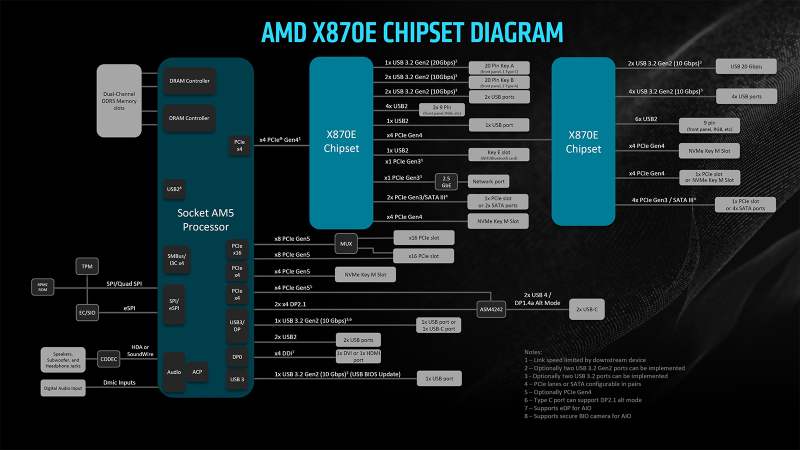
Thus, there is nothing really new in the AMD 800 series chipsets – they are the same X670E and B650E, but with a mandatory set of additional controllers. Moreover, such controllers do not always bring only advantages. For example, the addition of USB4, in addition to increasing the cost of boards, also leads to a reduction in available PCIe lanes. The ASM4242 chip needs 4 PCIe 4.0 lanes to operate, but the vast majority of motherboard manufacturers use PCIe processor lines rather than chipsets to connect it, which leads to either the disappearance of the second M.2 slot supporting PCIe 5.0 SSD from new boards, or their division lines with PCIe 5.0 x16 graphics slot. In other words, the use of 800-series system logic in a particular motherboard is clearly not an argument that should be used as a guide when choosing a platform.
To be convincing, let’s summarize what has been said with a table of characteristics of new and old chipsets, which clearly shows the insignificance of differences in the system logic sets for Socket AM5 boards.
⇡#Back to the Gigabyte X870E Aorus Pro Ice: specifications and delivery kit
Since AMD did not offer anything new in the 800 series chipsets, the entire burden of expanding the capabilities of X870E boards fell on the shoulders of their manufacturers. In this sense, testing the Gigabyte X870E Aorus Pro Ice promises to be educational. Getting to know this board should give you an understanding of whether there is any point in paying attention to Socket AM5 motherboards based on X870E, or whether it is a meaningless and more expensive variation of existing boards, where the markup is taken only for the novelty, and not for any useful additions .
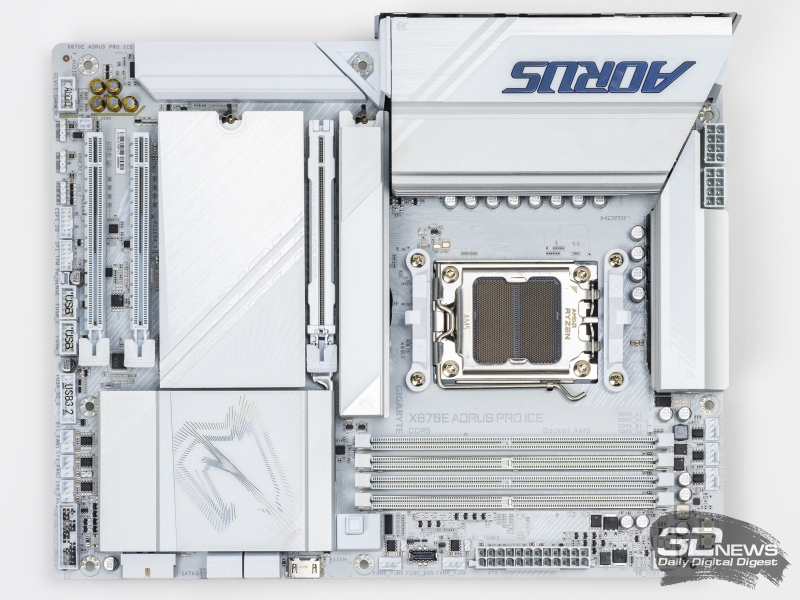
The specifications of the Gigabyte X870E Aorus Pro Ice are shown in the table below. From the list above, you can see that the board has fairly typical capabilities for an above-average Socket AM5 product. And there are no obvious advantages, with the exception of the presence of a pair of high-speed USB4 ports.
1 × PCIe x16 (4 PCI Express 4.0 lanes)
1 × M.2 (2280/22110) with PCIe x4 4.0 support
1 × USB 3.2 Gen2x2 Type C (20 Gbps)
2 × USB 3.2 Gen1 Type A (5 Gbps)
4 × USB 2.0
1 × F-Audio
1 × HDMI
1 × SPI TPM
3 × ARGB LED
1 × RGB LED
Additionally:
1 × noise sensor
1 × HDMI 2.1
4 × USB 3.2 Gen1 Type A (5 Gbps)
2 × USB4 Type-C (40 Gbps, DisplayPort)
3 × USB 3.2 Gen2 Type A (10 Gbps)
1 × RJ-45
2 x Antenna Wi-Fi
1 × S/PDIF Out
But to say that there is nothing new in the Gigabyte X870E Aorus Pro Ice would be unfair. This board has a direct predecessor with the same positioning, similar appearance and similar price, but based on the X670E chipset – X670E Aorus Pro X. And these two boards cannot be called synonymous – a lot has changed in the X870E Aorus Pro Ice.

However, most of the differences are insignificant. Wi-Fi 7 support was implemented by Gigabyte on the X670E board, so the fundamentally new features of the X870E Aorus Pro Ice include only a pair of USB4 ports located on the rear panel. Otherwise, the changes are quite secondary: adding support for PCIe 5.0 drives in the third M.2 slot, replacing two PCIe 3.0 lines with four PCIe 4.0 lines in the last PCIe x16 slot, replacing the 2.5 Gbps Intel I225-V network controller to a similar Realtek RTL8125D controller, plus an audio codec upgrade from ALC897 to ALC1220.
The Gigabyte X870E Aorus Pro Ice package also looks quite typical. In the box with it you can find:
- Wi-Fi antenna;
- Two white SATA cables;
- A set of branded stickers;
- Noise sensor;
- G-Connector block to facilitate connection of case buttons and indicators to the board.
⇡#Design and Features
Let’s start with the fact that the Gigabyte X870E Aorus Pro Ice is a very beautiful board. What Gigabyte definitely knows a lot about is creating boards that please the eye with their exterior. With the exception of a few black chips, the X870E Aorus Pro Ice is completely white, and even the slots and connectors are painted white, which is rare. The winter aesthetic chosen for this board fits perfectly with the light aluminum parts of the cooling system, as well as small plastic elements on the VRM heatsink and chipset. In short, the X870E Aorus Pro Ice looks more than harmonious and solid, but if for some reason the white color bothers you, Gigabyte has exactly the same board in black – the X870E Aorus Pro.
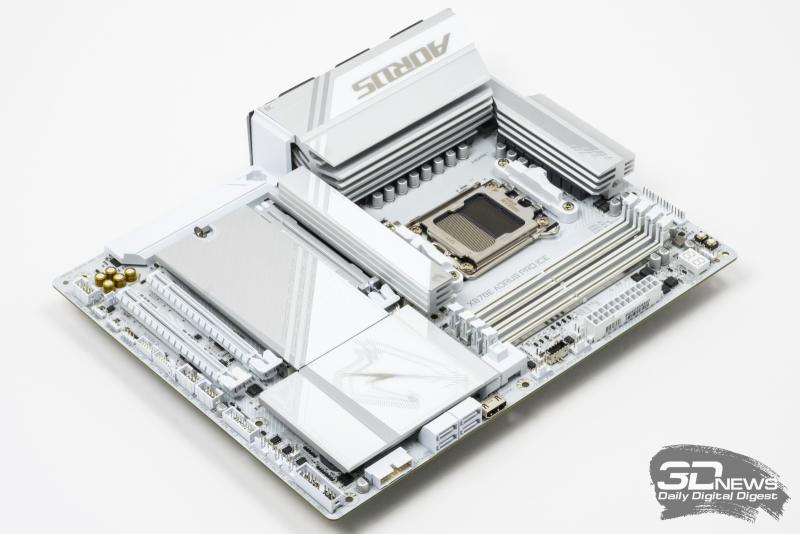
The issue with RGB backlighting has also been resolved quite delicately on the X870E Aorus Pro Ice. The board glows with the Aorus logo on the rear panel shroud, plus the surroundings of the chipset heatsink, under which several LEDs are placed, are softly illuminated. All this looks quite appropriate, but if desired, the backlight can be completely turned off – both in the proprietary software and in the Windows 11 settings. If, on the contrary, you want more backlighting, then the board has one 4-pin RGB 12 V interface (with a power of up to 36 W) and three 3-pin ARGB 5 V interfaces (up to 15 W each), to which additional LED strips can be connected.
The Gigabyte X870E Aorus Pro Ice is not only beautiful in appearance, but also carefully thought out in terms of hardware design. The first thing that deserves attention is the convincing cooling of the VRM area. Not only is there a pair of massive radiators with well-developed fins installed here, but a heat pipe is also used that distributes heat between them. Moreover, this cooling system is integral with the board’s rear panel shroud, which further increases the heat dissipation surface area.

The heatsink of the power converter is fraught with an unexpected surprise. If you remove it from the board, you will find another rather large radiator underneath it.
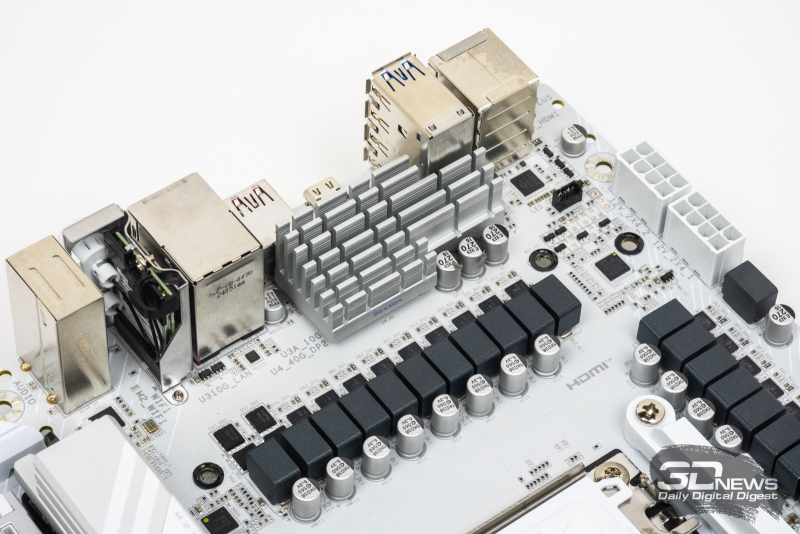
It removes heat from the ASMedia ASM4242 chip, an essential companion of the X870E chipset, which is responsible for operating USB4 ports with a bandwidth of up to 40 Gbps. Two Type-C ports of this type are located on the rear panel of the board in question, and a DisplayPort 1.4 signal from the integrated processor graphics can be output to them, so you can connect a monitor with a resolution of up to 3840×2160@240 Hz to them.
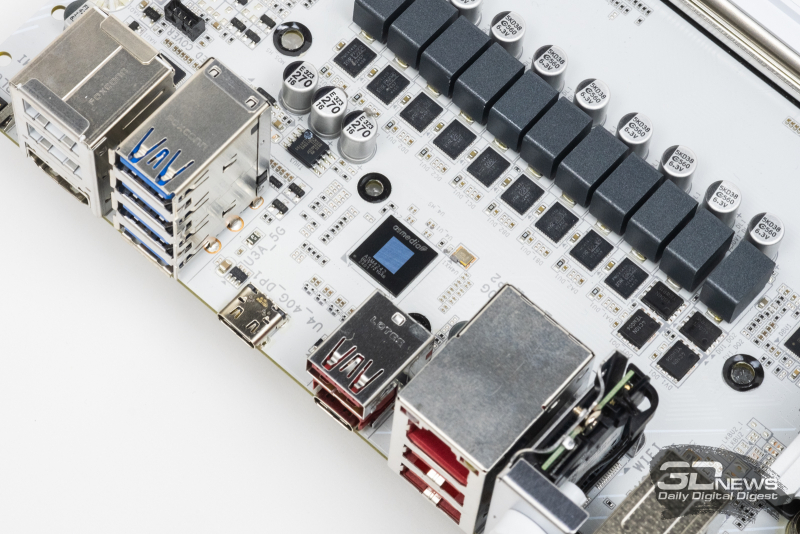
As for the processor power converter, on the X870E Aorus Pro Ice it is assembled according to an eight-channel scheme. It is controlled by an Infineon XDPE192C3B PWM controller, and Infineon PMC41410 integrated assemblies are used as power elements – two in each channel. As a result, the peak power of the entire converter reaches 1280 A – more than enough to operate any Socket AM5 processors. The same PWM controller with the same assemblies provides the operation of two additional channels allocated to the processor SoC. The “2×8+2” processor power converter structure is the most common for X870E boards, and in this regard, Gigabyte engineers did not reinvent the wheel. However, on higher-level boards there are often power stages designed for a current of 110, not 80 A, which means that the power converter on the X870E Aorus Pro Ice has some simplifications and is not suitable for setting overclocking records.
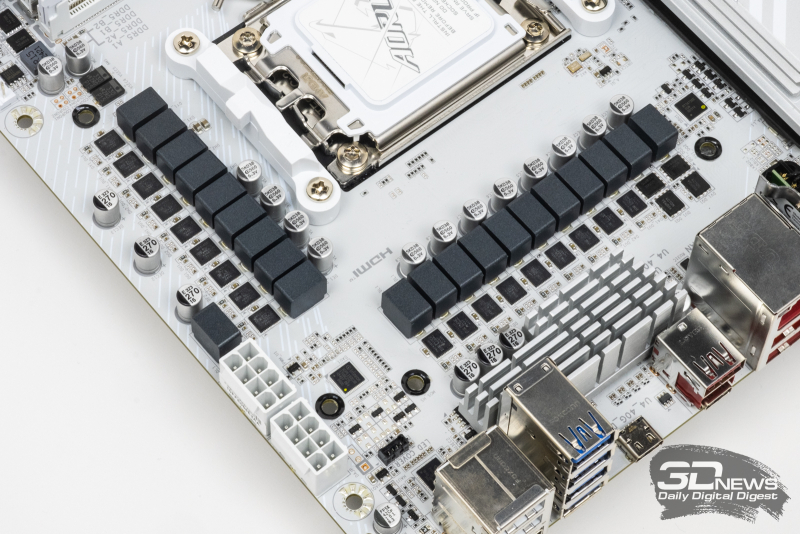
The fact that the motherboard in question does not have an obvious overclocking focus also follows from the structure of the printed circuit board, which has only six layers. Flagship boards Socket AM5 boards are usually based on 8-layer or even 10-layer PCB, which allows optimizing signal lines and providing them with additional shielding from electromagnetic interference. However, the six-layer design should not become a particular problem.
As if confirming this, Gigabyte talks about the ability of the X870E Aorus Pro Ice to work with 48 GB memory kits in DDR5-8200 mode and 32 GB kits in DDR5-8000 mode (naturally, when installed in two of the four available DIMM slots). It also deserves special mention that the board’s specifications state that it is compatible with memory sticks with a capacity of 64 GB, and this means that CUDIMM modules, when their support is added by AMD to the AGESA libraries, will be compatible with the X870E Aorus Pro Ice .
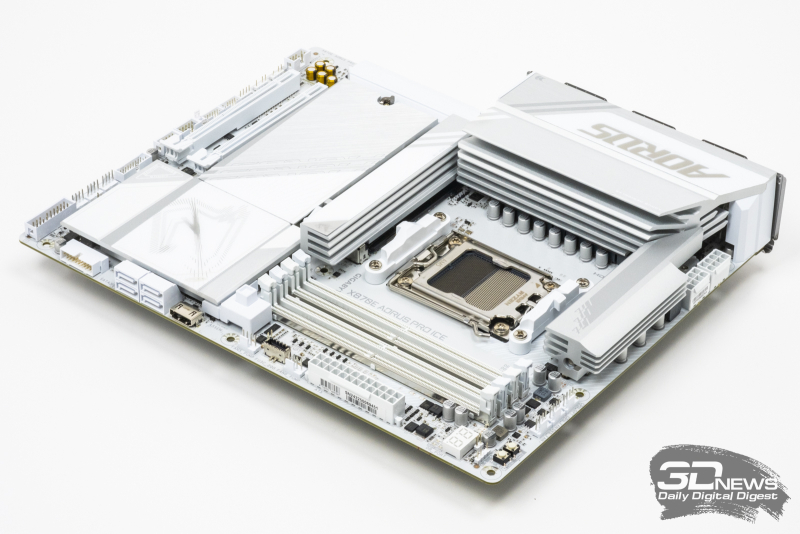
For expansion cards, the Gigabyte board in question has three PCIe x16 slots. Particular attention is paid to the first slot, intended for installing a video card. It is connected to 16 PCIe 5.0 lanes from the processor, but it is interesting primarily for its mechanical design. Gigabyte dressed it in metal armor, which prevents the slot from breaking out under the weight of heavy video cards.
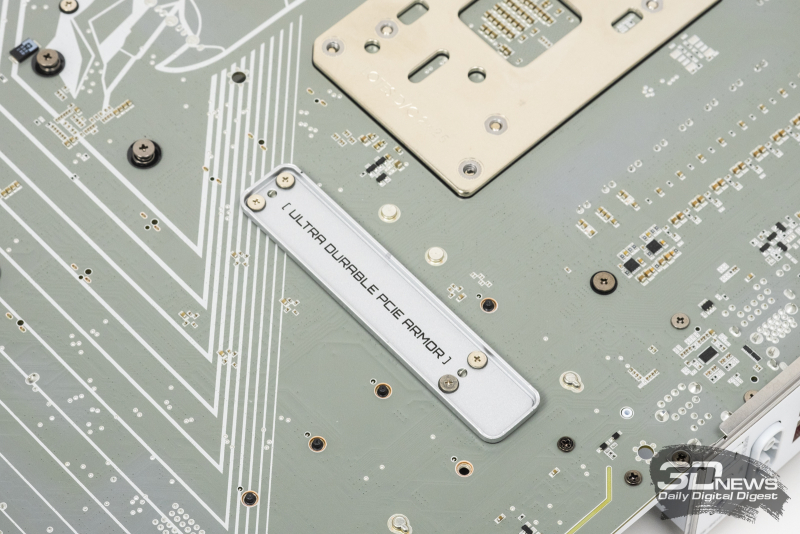
The slot-reinforcing frame is attached through to the reinforcement plate located on the back of the board, and this is the right solution, because the PCIe 5.0 x16 slot itself is surface-mounted to improve signal quality and does not have the necessary rigidity. Another interesting feature of this slot is a convenient button for removing video cards, replacing traditional latches, which can be difficult to get to in a fully assembled system.
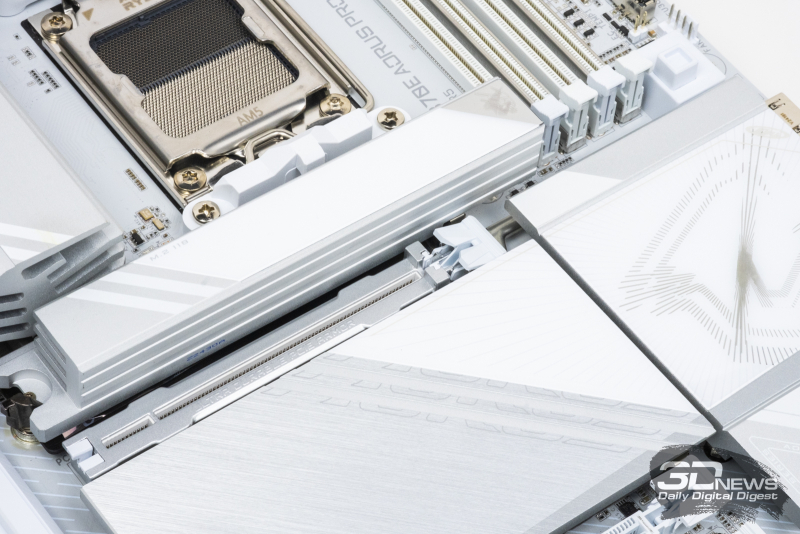
The second and third PCIe x16 slots are pushed to the bottom edge of the board on the X870E Aorus Pro Ice and play a secondary role. Both of them are connected to the chipset and receive four PCIe lanes. In one case these are PCIe 4.0 lines, in the second – PCIe 3.0.
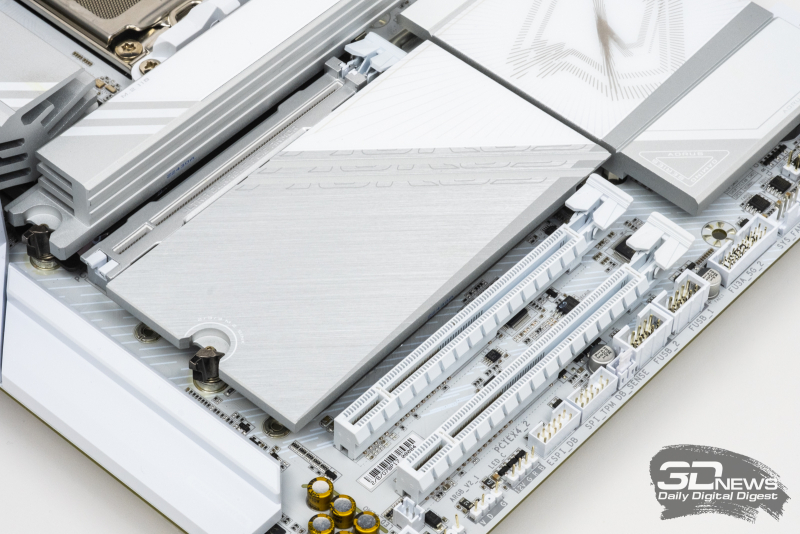
In the latest generations of motherboards, manufacturers have begun to try to add the maximum number of M.2 slots. The X870E Aorus Pro Ice was no exception – it had room for four such slots at once. At the same time, three slots are capable of working with PCIe 5.0 drives at full speed. And it would seem that this is an excellent set, but, unfortunately, not everything is so simple. Only the first slot, located in close proximity to the processor socket, has full support for PCIe 5.0 SSD. He got four PCIe 5.0 processor lines and high-quality cooling in the form of a massive radiator on top and a heat-dissipating plate on the bottom. It is in this slot that you need to install the fastest system SSD.
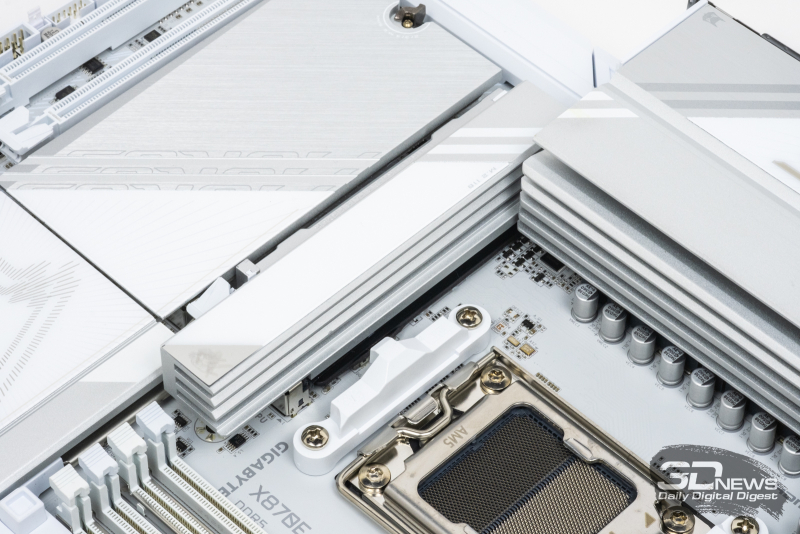
The second and third M.2 slots also formally use PCIe 5.0 processor lines, but they did not have enough of their own lines, and they take them away from the video card. That is, when installing at least one drive in the second or third M.2 slot, the video card will automatically switch from PCIe x16 mode to PCIe x8 mode, which, if a flagship GPU is used, will not have the best effect on its performance. In this regard, installing an SSD in the fourth M.2 slot is more painless – it receives four PCIe 4.0 lanes directly from the chipset and does not take anything away from anyone.
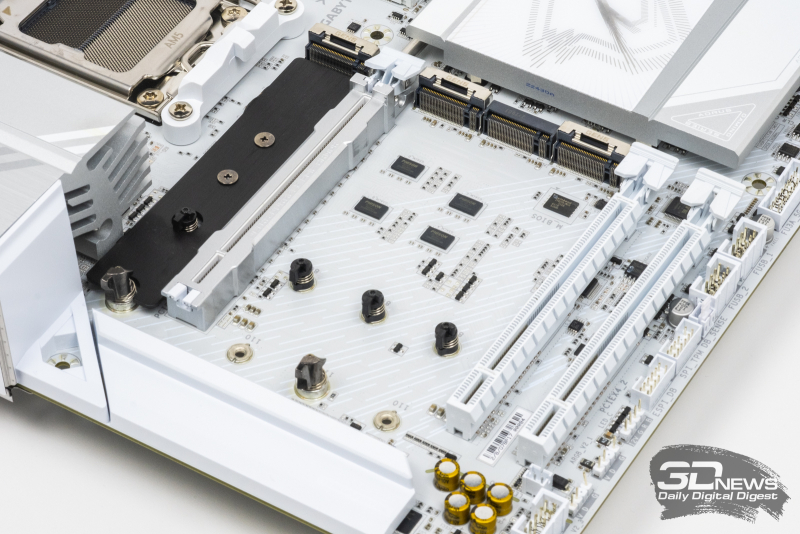
The second, third and fourth M.2 slots are placed on the board under a common heat dissipation plate, which, due to its area, can provide sufficient cooling for even the hottest drives. However, SSD cooling from below is not provided in these slots. But Gigabyte tried to simplify the process of installing M.2 SSDs into any slots as much as possible – both the radiators and the drives themselves are fixed on the board with spring latches rather than screws.
However, none of the M.2 slots on the board are compatible with SATA SSDs. For drives and hard drives with this interface, it is proposed to use four SATA ports.
The panel of external connectors of the Gigabyte X870E Aorus Pro Ice has a completely closed design, but the manufacturer has made perforations in the plug for the rear wall of the case, which it is very proud of, since with its help it was possible to reduce the temperature under the casing by as much as 7 degrees. As for the set of external ports, it includes HDMI 2.1 plus eleven different USBs: two USB4 Type-C ports (40 Gbps and DisplayPort support), three USB 3.2 Gen2x2 Type-A ports (20 Gbps), four USB 3.2 Gen2 Type-A ports (10 Gbps) and two USB 2.0 ports.
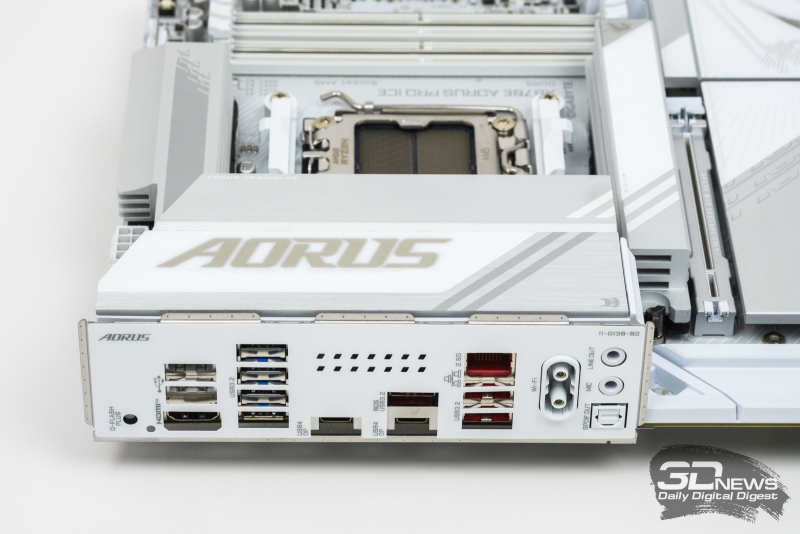
Also on the rear panel there is an RJ-45 connector for connecting the board to a wired network and two antenna connectors for Wi-Fi. The 2.5-Gbit Realtek RTL8125D controller is responsible for Ethernet operation. And the wireless network is implemented by the Qualcomm QCNCM865 Wi-Fi 7 adapter, which supports dual-band Wi-Fi 802.11be 2×2 technology, frequencies up to 6 GHz, 320 MHz channel, 4096-QAM encoding, and as a result, the maximum theoretical transmission speed over the air can reach up to 5.8 Gbit/s. The controller also supports the new Bluetooth 5.4 standard. It is curious that the antennas are connected to the Wi-Fi adapter not with traditional RP-SMA screw connectors, but with a proprietary WIFI EZ-Plug connector, which combines two TS9 connectors in a plastic frame. However, an antenna with the necessary connecting plug is included in the package.
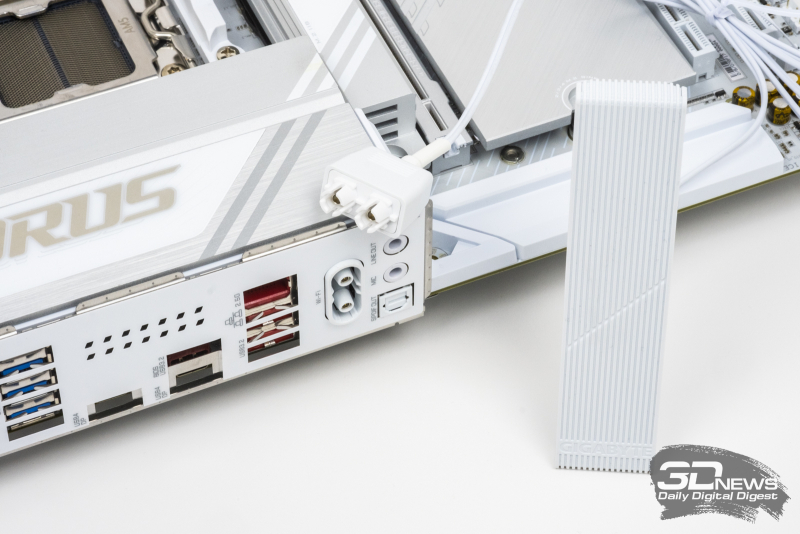
In the new generation Socket AM5 boards, manufacturers have taken a course towards reducing the number of analog audio connectors. The Gigabyte X870E Aorus Pro Ice reflects this trend clearly – only two 3.5 mm audio jacks plus an SPDIF output are located on its rear panel. However, this does not mean that the sound on the board is implemented according to the residual principle. It is responsible for the modern and high-quality Realtek ALC1220 codec, which supports 7.1-channel audio, playback of DSD streams, DTS:X Ultra technology, as well as automatic detection of headphones. As expected, the entire audio path is electrically separated from other circuits, and it uses Nichicon audio capacitors.
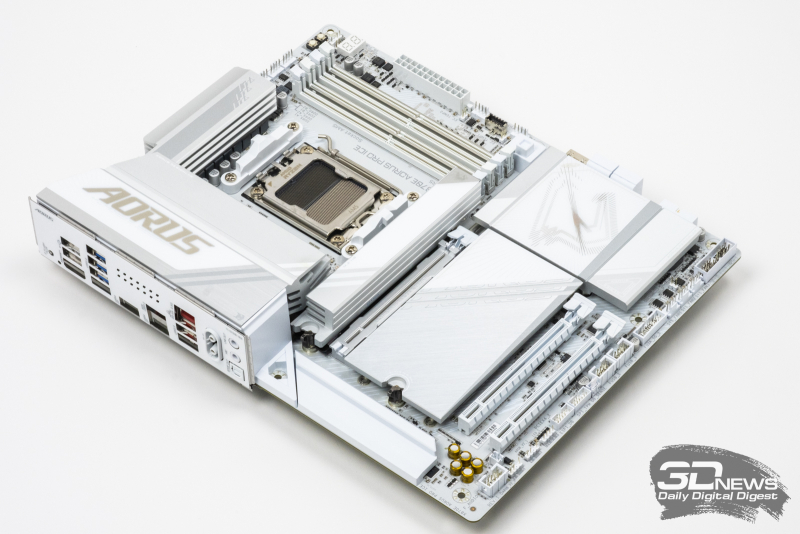
Speaking about the connectors that are present on the X870E Aorus Pro Ice, we cannot fail to mention the presence of a second HDMI port not on the rear panel of the board, but on its front edge. This connector is quite functional and is intended for connecting small monitors placed inside the case. Such solutions are sometimes used, for example, to constantly display hardware monitoring data, of which the Gigabyte X870E Aorus Pro Ice collects a lot.
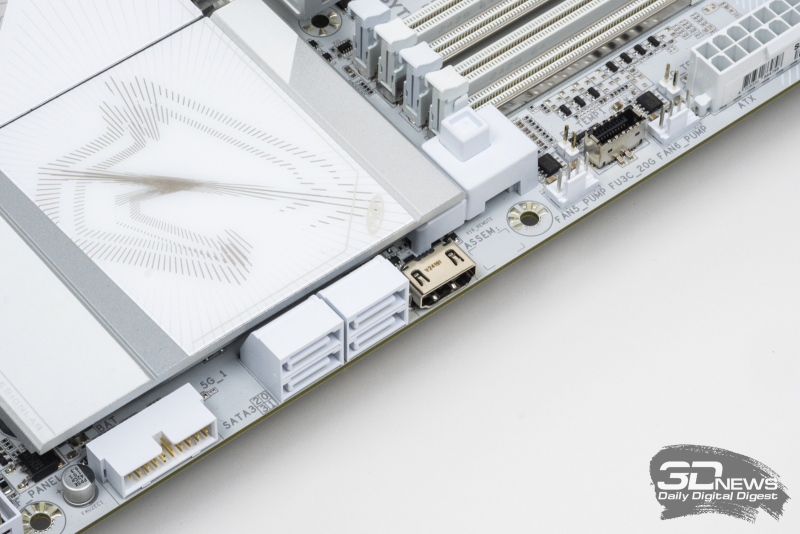
You can connect up to eight fans alone to it. Moreover, according to the manufacturer’s logic, two fan connectors are allocated for the processor cooler, two are for liquid cooling system pumps, and the remaining four connectors are for case fans. But the division is mostly formal. Each of the connectors is capable of delivering a current of up to 2 A to the connected device, and each has a speed control that can be linked to any of the temperature sensors, of which there are seven on the board, not counting a couple of additional connectors to which two more thermocouples can be connected. Only connectors for processor fans are limited in connection with sensors – their speed can depend solely on the temperature of the CPU.
In addition to its advanced monitoring capabilities, the X870E Aorus Pro Ice has other features that may make it appealing to enthusiasts. For example, it has physical power and reset buttons. In addition, the board is equipped with diagnostic LEDs that display the stages of the system startup process, and a POST code indicator that provides much more detailed information about what happens in the interval from pressing the power button until the image appears on the monitor.
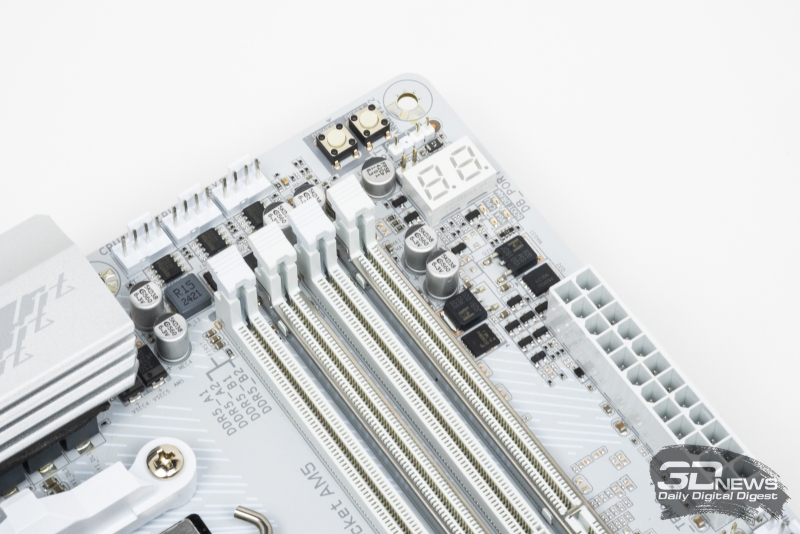
⇡#Test system
The Gigabyte X870E Aorus Pro Ice was tested using the following set of components:
- Processor: AMD Ryzen 9 9950X (Granite Ridge, 16 cores, 4.3-5.7 GHz, 64 MB L3).
- CPU cooler: custom LSS EKWB.
-
- Gigabyte X870E Aorus Pro Ice (Socket AM5, AMD X870E);
- MSI MPG X670E Carbon WiFi (Socket AM5, AMD X670E).
-
- 2 × 16 Гбайт DDR5-6000 SDRAM, 30-40-40-76 (Adata XPG Lancer Blade RGB DDR5 32GB 6000MHz AX5U6000C3016G-DTLABRBK);
- 2 × 16 Гбайт DDR5-7600 SDRAM, 36-46-46-121 (G.Skill Trident Z5 F5-7600J3646G16GX2-TZ5RK).
- Video card: GIGABYTE GeForce RTX 4090 Gaming OC (AD102 2235/2535 MHz, 24 GB GDDR6X 21 Gbps).
- Disk subsystem: Intel SSD 760p 2 TB (SSDPEKKW020T8X1).
- Power supply: ASUS ROG-THOR-1200P (80 Plus Titanium, 1200 W).
Tests were performed on the Microsoft Windows 11 Pro (23H2) Build 22631.4112 operating system using the following set of drivers:
- AMD Chipset Driver 6.07.22.037;
- NVIDIA GeForce 560.94 Driver.
Gigabyte X870E Aorus Pro Ice was tested with BIOS version F3d dated October 16, 2024.
⇡#BIOS
The BIOS shell currently used by Gigabyte is named after the abbreviation UC, which stands for User-Centered. This addition reflects the company’s desire to simplify system configuration for the end user, and in many ways it really succeeded. At least the simplified Easy Mode, which greets the user when entering the BIOS for the first time, has become informative and functional. In many situations, you can get by with it alone, without resorting to the help of the Advanced Mode.
However, enthusiasts who want to keep everything under control will like the advanced mode much more. Here, in the hierarchical directory familiar to Gigabyte boards, all possible settings are collected. The most interesting section is Tweaker, through which you can configure processor and memory parameters that directly affect performance.
In addition to the Tweaker section, the BIOS of the board in question allows anyone to configure the Favorites page by sending any settings to it. In the standard BIOS structure, such selected settings are marked with an asterisk, but they are also available separately in the corresponding section, which is opened by pressing the F11 key from both simplified and advanced modes.
It is worth noting that Gigabyte developers have already managed to make various optimizations to the BIOS for Ryzen 9000 processors. For single-chip processors, it has become possible to reduce the TDP to 105 W. And the much-advertised X3D Turbo Mode has also been added, which, according to Gigabyte, allows you to increase gaming performance by 20-35%, but in reality only disables SMT and the second CCD in dual-chip processors.
But another Gigabyte proprietary setting can be really useful – XMP/EXPO High Bandwidth Support. After applying the timing scheme from XMP/EXPO, its activation further reduces tRFC latency and increases tREFI, which quite noticeably improves performance and in most cases does not lead to disruption of system stability.
To configure computer cooling, the BIOS has a special subsection Smart Fan 6, which provides access to the dependence of the rotation speed of any fan on the temperature measured by one of the board’s thermal sensors.
You can thoroughly study how the BIOS of the Gigabyte X870E Aorus Pro Ice is organized and what settings it offers using the gallery of screenshots.
The voltage change intervals available to the user are shown in the table.
Thus, the BIOS capabilities are at a very good level. In terms of the wealth of available settings, the Gigabyte X870E Aorus Pro Ice is quite consistent with other flagship-level motherboards. Therefore, it is perfect for enthusiasts who want complete control over all system parameters.
⇡#Testing
Modern processors are characterized by fairly high consumption, which is why motherboard manufacturers add powerful power circuits made up of many phases. But sometimes it happens that the implemented circuits are not enough to work with flagship CPUs. To check that this does not happen with the Gigabyte X870E Aorus Pro Ice, we tested it under load with the Ryzen 9 9950X, a 16-core processor that can consume up to 200 W.
But the board coped with the test with dignity. The power of its power converter is sufficient with reserve, and the cooling system is quite efficient. During a half-hour rendering in Cinebench R23, the temperatures of the PWM controller and power stages did not go beyond 80 degrees. And this is a very good result, if we take into account the testing conditions, which assumed the absence of any airflow to the VRM area due to the use of a liquid CPU cooling system in the system.

There are no signs of overheating of the power circuit even when observing the board externally using a thermal imager.
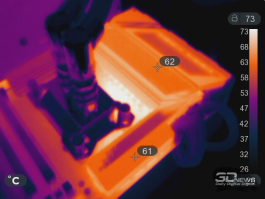
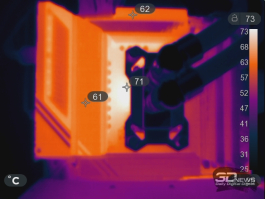
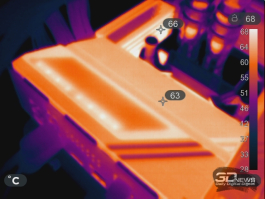
The maximum temperature that can be recorded outside is detected on the PCB in the VRM area. But it is also far from critical – only 70 degrees. So we can say with confidence that the power supply circuit of the Gigabyte X870E Aorus Pro Ice will certainly cope with any powerful processors of the past, present and future generations.
Moreover, this power supply scheme also has a fairly high efficiency of 92%. This value can be verified due to the fact that the X870E Aorus Pro Ice has advanced means of collecting VRM telemetry, allowing you to monitor not only general parameters, but also the loading of individual phases. Among other things, the efficiency of this circuit is calculated, which can be monitored in real time using the popular diagnostic utility HWInfo64.

For example, this is what the VRM efficiency graph looks like during testing in Cinebehch R23.
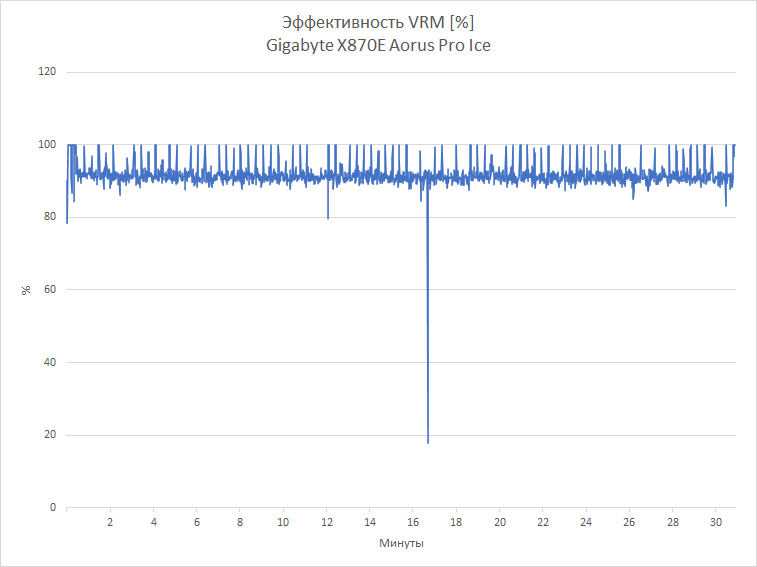
But the Gigabyte X870E Aorus Pro Ice is still not perfect. Do not forget that it is designed on the basis of a six-layer printed circuit board, and this affects certain aspects of its operation. In particular, it was unable to work stably with memory in DDR5-8000 mode. The system booted, but stability tests inevitably resulted in errors. But when using DDR5-7600, no problems arose – the X870E Aorus Pro Ice can handle such memory without any failures.
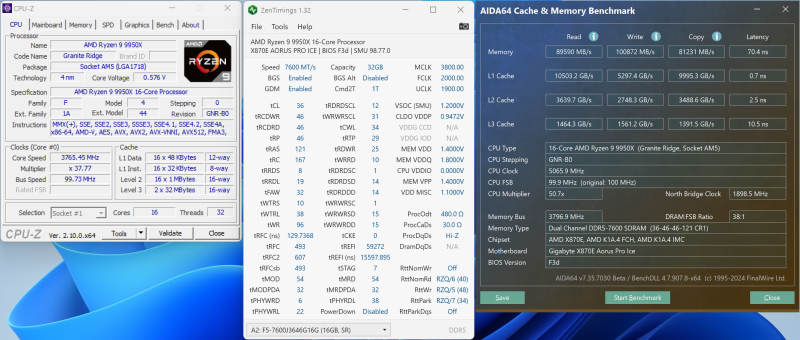
Although AMD promised that models based on the X870E chipset should work with memory in DDR5-8000 mode, in reality everything again comes down to motherboards. As it turned out, the capabilities of the Gigabyte X870E Aorus Pro Ice to support high-speed memory are no different from what was offered by boards based on the X670E, and DDR5-7600 is the maximum for this board. However, increasing the memory frequency above DDR5-6000/6400 in the Socket AM5 platform requires switching the memory controller to half-frequency mode, which leads to an increase in latency. Therefore, using high-speed memory with Ryzen processors does not make much sense, and the fact that DDR5-8000 could not work completely stably on the board in question is not such a big loss.
In conclusion, it remains to compare the level of performance provided by the Gigabyte X870E Aorus Pro Ice with the previous generation board based on the X670E chipset. As a starting point, we chose the MSI MPG X670E Carbon WiFi – the motherboard we use in all AMD processor tests.
Ryzen 9 9950X
DDR5-6000, 30-40-40-76MSI MPG X670E Carbon WiFi
Ryzen 9 9950X
It turns out that the Gigabyte X870E Aorus Pro Ice provides about the same performance for a Ryzen 9 9950X-based system as the older MSI MPG X670E Carbon WiFi. But the Gigabyte board is still a little faster, and this is quite natural. The X870E and X670E chipsets are close relatives, and AMD is developing a single branch of AGESA libraries for all Socket AM5 systems. However, boards based on the X870E are hot new products, and all the efforts of manufacturers are now aimed at optimizing and debugging their firmware. Therefore, they receive the latest versions of the AGESA libraries and the latest optimizations first – a little earlier than boards based on the X670E.
⇡#Conclusions
The new X870E chipset is actually a renamed X670E, so boards based on it do not have any fundamental innovations. Support for Wi-Fi 7 was found in Socket AM5 motherboards even before the release of the X870E, and the appearance of USB4 ports in them was implemented not by the chipset at all, but by an external controller, due to which boards based on the X870E lost one of the two M.2 slots connected directly from processor with PCIe 5.0 lines. In other words, there is nothing in AMD’s new system logic that would make motherboards based on it automatically gain any tangible advantages over their predecessors.
In such conditions, the responsibility for innovation passed to motherboard manufacturers, and the Gigabyte X870E Aorus Pro Ice is just an example of such a board in which its developers tried to compensate for AMD’s marking time. But, unfortunately, it didn’t turn out to be very convincing. The X870E Aorus Pro Ice does not have any powerful technical trump card that would make it stand out sharply against the background of Socket AM5 solutions of the previous generation.
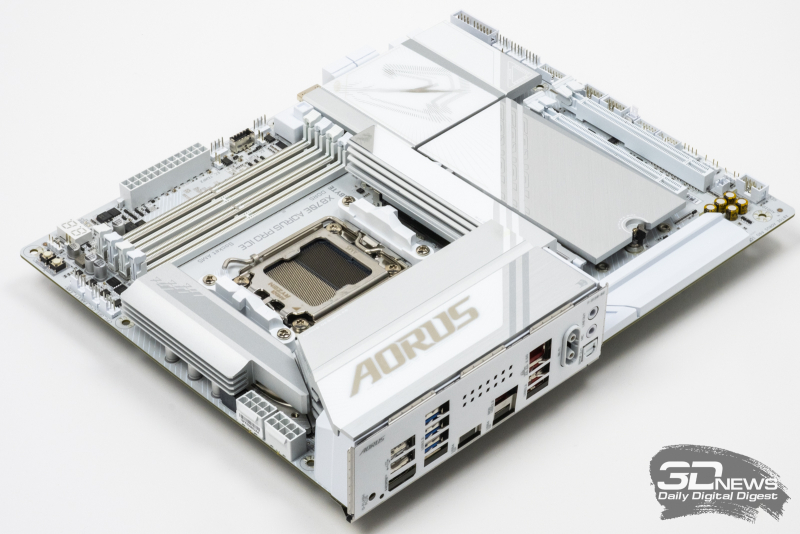
Nevertheless, in terms of the totality of its capabilities, the Gigabyte X870E Aorus Pro Ice looks like a quite worthy platform for Ryzen processors of the 7000, 8000 and 9000 series. It has a powerful and efficient power design that can easily cope with flagship 16-core processors; serious attention is paid to heat removal from all hot components; there is a POST code indicator and Power and Reset buttons; There are as many as eight connectors for connecting fans; and also a comprehensive set of expansion slots is implemented. In addition, Gigabyte made sure that its board was comfortable to assemble: it’s difficult to make any complaints about its layout; M.2 slots have latches instead of screws; and removing the video card from the PCIe 5.0 slot is done using an easily accessible button.
But the main feature of the X870E Aorus Pro Ice, because of which it makes sense to choose it as the basis of a PC, is its appearance. After all, this is a spectacular and unique white Socket AM5 motherboard with white DIMM and PCIe slots, which can charm literally anyone who thinks about what their computer looks like. And obviously, it is the aesthetic component that will become the main factor that will determine the popularity of this board.
At the same time, the beauty of the Gigabyte X870E Aorus Pro Ice does not require sacrifice. This board is perfect for high-performance gaming PCs built with the latest technology. On the one hand, it has everything a modern system needs, including support for USB4, 2.5 Gbps network and Wi-Fi 7. On the other hand, it does not at all limit the ability to fine-tune the operating modes of the processor and memory, which should will appeal to enthusiasts who will surely be able to achieve the desired improvements in performance and energy efficiency with its help.